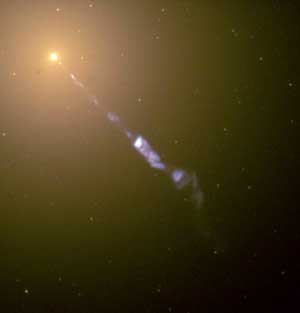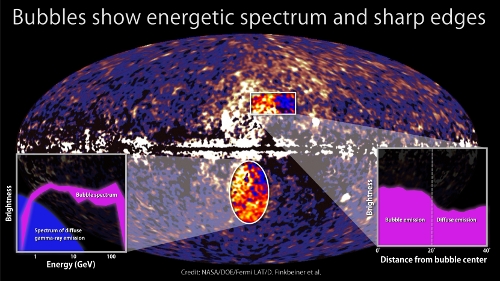
Did the Milky Way once have a jet powered by matter falling into the supermassive black hole at galactic center? There is little evidence for an active jet today, but we do see jets like these in so-called ‘active galaxies,’ those that show higher than normal luminosity over much of the electromagnetic spectrum. Some jets in active galaxies can be thousands of light years long, evidently emerging from each face of the accretion disk around a central black hole in the so-called active galactic nucleus (AGN). And on a smaller level, we’ve found similar jets emerging from the accretion disks around neutron stars and stellar-mass black holes.
Image: Streaming out from the center of the galaxy M87 like a cosmic searchlight is one of nature’s most amazing phenomena, a black-hole-powered jet of electrons and other sub-atomic particles traveling at nearly the speed of light. In this Hubble telescope image, the blue jet contrasts with the yellow glow from the combined light of billions of unseen stars and the yellow, point-like clusters of stars that make up this galaxy. Lying at the center of M87, the monstrous black hole has swallowed up matter equal to 2 billion times our Sun’s mass. M87 is 50 million light-years from Earth. Credit: NASA and The Hubble Heritage Team (STScI/AURA).
The Milky Way’s massive black hole seems quiescent today, but there remains the possibility that it produced a jet in the past, a notion piqued by the recent discovery of a previously unseen structure spanning some 50,000 light years. It took intensive processing of data from the Large Area Telescope (LAT), the highest-resolution gamma-ray detector ever launched, to make the find. The LAT is the main instrument of the Fermi Gamma-Ray Space Telescope, formerly known as GLAST (for Gamma-ray Large Area Space Telescope). Doug Finkbeiner (Harvard-Smithsonian Center for Astrophysics) lays out the find in stark terms:
“What we see are two gamma-ray-emitting bubbles that extend 25,000 light-years north and south of the galactic center. We don’t fully understand their nature or origin.”
Earlier data from the Wilkinson Microwave Anisotropy Probe and the Roentgen Satellite have suggested evidence for part of the structures, now called ‘Fermi bubbles,’ near the galactic center, but the Fermi LAT results go further in suggesting the extent and surprisingly well-defined nature of the bubbles. Perhaps these are survivors of ancient jet activity, but relating the structures to jets brings its own set of problems, as the paper on this work notes:
…the north-south symmetry of the bubbles has no obvious explanation in the context of an AGN jet: there is no reason for one jet to be oriented perpendicular to the Galactic plane. The large width and rounded shape of the bubbles are also not typical of jets, which are generally much more collimated, although a precessing jet might help explain the wide opening angle of the bubbles. If the central MBH becomes active on a relatively short timescale, the Fermi bubbles may be created by a number of past jets, which combine to give rise to the symmetric and uniform Fermi bubbles.
And if past jets are not the cause, one alternative is a burst of rapid star formation, which can likewise drive a huge outflow of gas. Whatever the case, the structures may be millions of years old and they span half the visible sky. Yet they have remained undetected because particles moving near the speed of light interact with interstellar gas in the Milky Way, creating a fog of gamma rays (the ‘diffuse emission’) that has until now obscured the bubbles.
Image: The bubbles display a spectrum with higher peak energies than the diffuse gamma-ray glow seen throughout the sky. In addition, the bubbles display sharp edges in Fermi LAT data. Both of these qualities suggest that the structure arose in a sudden, impulsive event, such as an eruption from the Milky Way’s black hole or a rapid surge of star formation in the galactic center. Credit: NASA/DOE/Fermi LAT/D. Finkbeiner et al.
Centauri Dreams reader Antonio Tavani passed along links to the Italian coverage of the Fermi bubbles, and wondered whether this large, previously undetected structure might have implications for the Fermi paradox, the ‘where are they’ question that puzzles those who believe interstellar travel, even if limited to a fraction of light speed, is all but inevitable. It’s an interesting question. Are we seeing the remnant of high-energy jet activity that could have suppressed early life on worlds too near galactic center? At this point, all we can do is speculate, while noting that the emissions suggest the structure formed as the result of a large and rapid energy release.
The paper is Meng Su et al., “Giant Gamma-ray Bubbles from Fermi-LAT: AGN Activity or Bipolar Galactic Wind?” accepted by The Astrophysical Journal (preprint).




Would definitely be interesting to know whether the Milky Way had an active galactic nucleus during the Earth’s history.
Nice article Paul.
I’ve been looking for such bubbles for a long time :) no kidding though.
My theoretical model predicted such clouds 27 years ago and they have been implied by the model since its beginning 50 years ago. Here is the present wording of the prediction below:
#22) ” Most large Galaxies would have been (are) created from the inside out. Most of the matter and stars of any large galaxy would have been produced from field material (aether) surrounding the central black hole and ejected in large polar jets or polar emitted clouds, primarily in the form of protons and electrons. The first stars formed would have formed close to the central black hole of the galaxy and slowly would have moved outward as new stars were formed closer in. Through gravitational interactions between stars within the newly forming galactic bulge some newly formed stars would be hurled outward to form the outer galaxy. As the galaxy ages, new stars would form both in the core and outwardly to the farthest reaches of the galaxy.”
If this observation(s) is valid I think it is proof of theory. The theory is that all galaxies that have large central black holes, that most of the matter withing the galaxy would have been created within and surrounding the central black hole. This new matter accordingly would be created from a particle aether like field (the ZPF), primarily protons, electrons, and positrons. Anti-protons are accordingly relatively short-lived particles. Black Holes and neutron stars would be the only new matter creation mechanism from a particle field in the universe, no Big Bang.
Of course this observation does not prove anything concerning the alternative model but I consider it evidence for this model which is called the Pan Theory.
http://www.technologyreview.com/blog/arxiv/27211/
Fermi Bubbles Are Burps from a Star-Eating Black Hole
…and they may also explain the cosmic ray “knee” problem, one of astronomy’s biggest mysteries.
kfc 09/30/2011
Last year, astronomers analysing data from NASA’s orbiting Fermi Gamma Ray Telescope made an extraordinary announcement. They said that Fermi had spotted two giant bubbles emanating from the centre of the galaxy, stretching some 20,000 light years above and below the galactic plane.
These bubbles are clearly some kind of shockwave in which high energy electrons interact with photons, giving up their energy in the form of gamma rays.
But what could have caused such a shockwave, which is many times bigger than astronomers would expect to see from a supernova?
Today, Kwong Sang Chen at The University of Hong Kong and a few pals say think they know. They say the bubbles are the remnants of stars that have been eaten by the supermassive black hole at the centre of the galaxy. What’s this idea may also explain the energy distribution of cosmic rays, which astronomers have puzzled over for decades.
Our galaxy’s supermassive black hole is, well, huge–some 4 million times more massive than the Sun. Chen and co assume that a star falls into it every 1000 years or so. When this happens, part of the star is devoured by the black hole, while the rest is burped back out into space in the form of high energy protons.
These protons heat up the gas and dust surrounding the black hole creating an expanding bubble of high energy electrons. This cannot expand far in the plane of the galaxy where it is absorbed.
But the electrons can travel far into the space above and below the galactic plane, creating the gamma ray bubbles seen by Fermi. This explains why the edge of the bubble is so well defined.
But it also explains another of the great puzzles that astronomers are sweating over: the strange energy distribution of cosmic rays.
It’s easy to imagine that higher energy cosmic rays ought to be rarer than lower energy ones. But when astronomers plot the number of cosmic rays against energy, there are far more high energy ones than there ought to be. These form a ‘knee’ in the graph, hence the name of the problem.
Chen and co’s model explains this knee. They say the extra high energy cosmic rays must be protons created during this star-eating process that have made their way to Earth.
So it is the sheer size and energy of the black hole burp that generates the extra high energy protons in the spectrum.
A convincing argument that kills two birds with one stone.
Ref: http://arxiv.org/abs/1109.6087: Fermi Bubbles as a Result of Star Capture in the Galactic Center